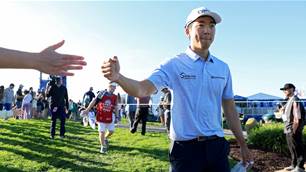Good seats at sporting events are often underpriced, while the bad seats are overpriced.
 photo by Getty Images
photo by Getty ImagesGood seats at sporting events are often underpriced, while the bad seats are overpriced.
Your columnist, for his sins, attends a lot of golf tournaments, and was heartened by what appeared to be a sea-change shift in attitude out on course at recent events. It used to be that if you brought a phone through the gates you’d be treated like you were smuggling in a concealed weapon. Golf, after all, was seemingly invented as a way to get away from phones, the office, family members or everyday commitments in general.
Now, tournament organisers have given in, to the point they now even encourage you to download an official app or post to Twitter or Facebook. The faint throb of a mobile on vibrate is the sound of inevitability. Asking spectators at a sporting event to ditch their phone makes about as much sense these days as asking them to leave their wallets at home. The more progressive elements in the trade of live events have recognised personal tech for what it is – the way to revive the time-honoured practice of being there, encapsulated in a piece of sports-business jargon fast gaining currency: “improving the fan experience”.
As it stands, in the contest between going to the game and watching on your couch at home, the couch has been winning, well, comfortably. The advent of the HD flatscreen era sealed it, more than enough to dissuade sports fans from talking themselves into paying for seats with bad sightlines and overpriced parking. The people in charge of sports were compliant, happy to help the TV product get better (it was where their biggest source of cash was coming from) and watch as the crowds at the ground became the backdrop.
In a flush economy, when another corporate box buyer was always waiting in line, this was fine. But as times get tighter, sports are being forced to look hard at their sources of income, which means holding on to all the paying customers they can.
So, cue: “improving the fan experience”. It’s a coded phrase, really; a way of tacitly acknowledging that the fans who cared enough to turn up and pay weren’t getting treated as well as those who didn’t leave their living room. The chief executive of Ticketmaster in the US, Nathan Hubbard, has been a proponent of the idea that the entire process of going to a sports (or other live) event had to be overhauled, right from the moment spectators decide on buying a ticket.
One of Hubbard’s key points is that the good seats at sporting events are often underpriced, while the bad seats are overpriced. It’s this disparity, and lack of flexibility, that makes the pre-sale market possible. In his vision, the interaction between fan and sporting event will look a lot like buying an airline seat: dynamic pricing that changes with time and demand, information-rich loyalty programs and paperless ticketing.
Just like you can use your phone as your boarding pass, it will also be your way into the game. And once inside the stadium or arena, and on the event’s Wi-Fi, there would be further uses for technology, such as accessing news feeds, stats or replays that spectators would expect while watching on TV or following on their computer. Social media integration and location services shape as a large part of the in-game experience of the future – it often seems that the entire purpose of Twitter is to let everyone know about the cool thing you could only see by being in the crowd.
Just as phone company advertising has been telling us for years, sporting events essentially sell the idea of connecting a group of people. And now there are ways to push those connections out farther and faster. The best part of the fan experience is feeling like you’re part of something larger – although you’ll never feel quite so alone when your phone rings in the middle of a golfer’s backswing.
‒ Jeff Centenera
Related Articles

Morri: Social media done right

McIlroy: Golf ball change won't affect average golfers













